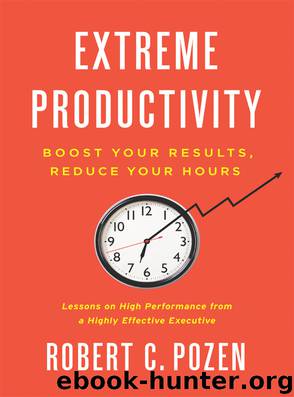Extreme Productivity: Boost Your Results, Reduce Your Hours by Robert C. Pozen

Author:Robert C. Pozen [Pozen, Robert C.]
Language: eng
Format: epub, mobi
Tags: General, Business & Economics, Leadership, Time Management
ISBN: 9780062188533
Publisher: HarperCollins
Published: 2012-10-02T00:00:00+00:00
Another possible structure might be:
• Here’s an issue of current interest.
• Here’s my take on this issue.
• Here’s how we might rethink this issue in the future.
In putting together the body of a speech, remember that you are trying to persuade your audience to accept your viewpoint. Even if you’re just giving a status report, you’re trying to convince your colleagues that the project is going well—or maybe that it isn’t. In any case, it is easy enough to be applauded by people who already agree with you. It is more difficult to win over people who were previously neutral or against your position. How can you win them over?
Occasionally you can rely on the strength of your analysis and supporting information, especially if they are little known to your audience or run counter to the conventional wisdom. But speaking is more of an emotional than an intellectual experience, and I don’t recommend relying only on logic. If you want to persuade people, present examples or anecdotes as well as arguments. Your audience is more likely to be moved by vivid stories about a few individuals addicted to alcohol than a chart showing abstract statistics on alcohol abuse.3
Similarly, your audience will be more receptive to your ideas if they can tell that you really care about the subject. To convey emotion, use dramatic gestures and vary your tone of voice. Repeat the same phrase several times, add some strategic pauses to underscore key ideas, and put multiple ideas into a parallel structure to stress how they connect to each other.
If feasible, reach an emotional crescendo near the end of your speech. I know the typical advice to speakers goes like this: “Tell them what you’re going to say, then say it, and then conclude by telling them what you’ve just said.” I strongly disagree—it’s boring for an audience to hear again the points you’ve just told them. Instead, use your conclusion to leave your audience in a certain frame of mind—say, inspired to donate to your cause or curious to learn more about your company.
In your conclusion, offer your audience a few takeaways—key points you want them to remember. One takeaway could be a call to action, such as taking market share away from your main competitor. Another takeaway could be to adopt a different perspective on a subject: “The next time you see a critical article on U.S. foreign aid, I want you to think about how little the United States actually spends on aid relative to the entire budget.” Or a takeaway could be a plea to change the personal behavior of your audience, such as Steve Jobs’s appeal from his highly praised Stanford commencement address: “Stay hungry, stay foolish.”4
Finally, you should close by thanking your host for giving you the opportunity to speak at their meeting or conference.
Download
Extreme Productivity: Boost Your Results, Reduce Your Hours by Robert C. Pozen.mobi
This site does not store any files on its server. We only index and link to content provided by other sites. Please contact the content providers to delete copyright contents if any and email us, we'll remove relevant links or contents immediately.
The Compound Effect by Darren Hardy(8530)
Tools of Titans by Timothy Ferriss(7831)
Nudge - Improving Decisions about Health, Wealth, and Happiness by Thaler Sunstein(7262)
Win Bigly by Scott Adams(6838)
Deep Work by Cal Newport(6592)
Rich Dad Poor Dad by Robert T. Kiyosaki(6196)
Pioneering Portfolio Management by David F. Swensen(6092)
Principles: Life and Work by Ray Dalio(5991)
The Barefoot Investor by Scott Pape(5600)
Digital Minimalism by Cal Newport;(5398)
Grit by Angela Duckworth(5303)
The Slight Edge by Jeff Olson(5205)
Discipline Equals Freedom by Jocko Willink(5160)
The Motivation Myth by Jeff Haden(5011)
You Are a Badass at Making Money by Jen Sincero(4659)
The Four Tendencies by Gretchen Rubin(4429)
Eat That Frog! by Brian Tracy(4169)
The Confidence Code by Katty Kay(4049)
Bullshit Jobs by David Graeber(3851)
